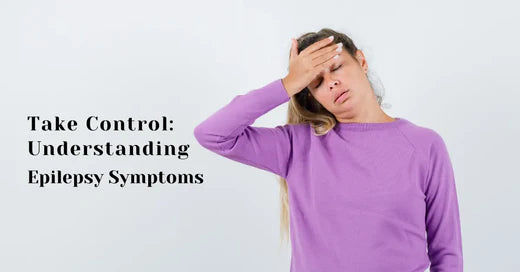
Take Control: Understanding Epilepsy Symptoms
Share
Epilepsy is a neurological disorder that affects millions of people worldwide. It is characterized by recurrent, unprovoked seizures resulting from abnormal electrical activity in the brain. Understanding epilepsy symptoms is crucial for early diagnosis and effective management of the condition. This blog post delves into the causes, signs, and symptoms of epilepsy to provide a comprehensive overview of this complex disorder.
Causes of Epilepsy
The exact cause of epilepsy is not always identifiable, but several factors can contribute to the development of this disorder. These include:
- Genetic Factors: Some types of epilepsy are inherited, indicating a genetic predisposition. Mutations in specific genes can affect brain function and increase the risk of seizures.
- Brain Injury: Traumatic brain injuries, such as those sustained in accidents or sports, can lead to epilepsy. The severity and location of the injury play a significant role in the likelihood of developing the condition.
- Infections: Certain infections, such as meningitis, encephalitis, and HIV, can cause inflammation in the brain, potentially leading to epilepsy.
- Stroke: Strokes, which result from interrupted blood flow to the brain, can cause brain damage and trigger epilepsy, particularly in older adults.
- Developmental Disorders: Conditions such as autism and neurofibromatosis are associated with a higher risk of epilepsy.
- Prenatal Injury: Brain damage that occurs before birth, often due to maternal infections, poor nutrition, or oxygen deficiencies, can result in epilepsy.
Recognizing Epilepsy Symptoms
Seizures manifest differently depending on the affected brain region. Some cause physical convulsions (often referred to as "fits"), while others lead to altered consciousness or unusual sensory experiences. These episodes can last from a few seconds to several minutes and may occur during wakefulness or sleep. Sometimes, specific triggers such as extreme fatigue can provoke seizures.
Types of Seizures
1. Simple Partial (Focal) Seizures or 'Auras'
During a simple partial seizure, you remain conscious and might experience:
- A vague, hard-to-describe sensation
- A "rising" feeling in the stomach similar to being on a fairground ride
- A sense of déjà vu
- Unusual smells or tastes
- Tingling in limbs
- Intense feelings of fear or joy
- Stiffness or twitching in a body part like an arm or hand
These seizures are often called "auras" because they can signal the onset of a more severe seizure.
2. Complex Partial (Focal) Seizures
In a complex partial seizure, consciousness is impaired, and you may exhibit behaviours like:
- Lip-smacking
- Hand rubbing
- Random noises
- Arm movements
- Picking at clothes or objects
- Chewing or swallowing
During these seizures, you cannot respond to others and won't remember the event.
3. Tonic-Clonic Seizures
Previously known as "grand mal" seizures, tonic-clonic seizures are the stereotypical epileptic fits, occurring in two phases:
-Tonic Phase: Loss of consciousness and body stiffness, often causing falls.
- Clonic Phase: Limbs jerk uncontrollably, possible loss of bladder or bowel control, tongue or cheek biting, and breathing difficulties.
These seizures usually last a few minutes, but can sometimes be longer. Post-seizure, you may experience headaches, confusion, and fatigue.
4. Absence Seizures
Formerly called "petit mal" seizures, absences involve brief lapses in awareness, predominantly affecting children. Symptoms include:
- Blank staring
- Daydreaming appearance
- Eye fluttering
- Minor body or limb jerking
These seizures are brief, lasting up to 15 seconds, and can occur multiple times daily.
5. Myoclonic Seizures
Myoclonic seizures cause sudden, brief jerks or twitches, often upon waking. These seizures last a fraction of a second and typically do not affect consciousness.
6. Clonic Seizures
Clonic seizures involve rhythmic shaking and jerking without the initial stiffness seen in tonic-clonic seizures. They usually last a few minutes and can cause a loss of consciousness.
7. Tonic Seizures
Tonic seizures cause sudden muscle stiffness, similar to the tonic phase of tonic-clonic seizures, which can result in falls.
8. Atonic Seizures
Atonic seizures lead to a sudden relaxation of muscles, causing falls. These seizures are brief, and you can typically stand up immediately afterwards.
9. Status Epilepticus
Status epilepticus refers to prolonged seizures or a series of seizures without regaining consciousness between them. This is a medical emergency requiring immediate treatment. If untrained, call emergency services if a seizure lasts more than 5 minutes.
Various Seizure Triggers
For many with epilepsy, seizures occur randomly, but certain triggers can provoke them, such as:
- Stress
- Sleep deprivation
- Awakening
- Alcohol consumption
- Certain medications and illegal drugs
- Menstrual periods in women
- Flashing lights (a rare trigger)
Understanding and managing epilepsy involves recognizing symptoms and triggers. If you or someone you know has epilepsy, proper treatment and support can lead to a fulfilling life. Always consult healthcare professionals for personalized advice and treatment plans.

First Aid for Seizures: Do’s and Don'ts
It's essential to understand that most seizures don't require emergency medical intervention, and once a seizure starts, it cannot be stopped.
If you're with someone having a mild seizure:
- Stay with them until the seizure ends and they regain consciousness.
- Guide them to a safe place once they're awake and explain what happened.
- Remain calm and help others around you stay calm.
- Speak soothingly.
- Look for a medical bracelet that may provide important information.
- Offer assistance in getting them home safely.
For a tonic-clonic seizure, characterized by uncontrolled shaking or jerking:
- Gently ease the person to the ground.
- Turn them onto their side to aid breathing.
- Clear the area of any potentially harmful objects.
- Place something soft under their head.
- Remove their glasses if they wear any.
- Loosen any restrictive clothing, such as a tie, to ensure easy breathing.
- Time the seizure, and if it lasts longer than five minutes, call 911.
- During a seizure, never:
- Hold the person down or try to restrain their movements.
- Place anything in their mouth.
- Perform mouth-to-mouth resuscitation.
- Offer them food or water until they are fully alert.
Can Epilepsy be Cured?
Currently, there is no definitive cure for epilepsy, but it can often be effectively managed with appropriate treatment. Here are some key points:
- Medications: The majority of people with epilepsy can control their seizures with anti-epileptic drugs (AEDs). These medications help stabilize the electrical activity in the brain. For about 70% of patients, seizures can be completely controlled with these drugs.
- Surgery: For those who do not respond to medication (approximately 30% of patients), epilepsy surgery may be an option. Surgical procedures can remove the part of the brain causing the seizures or interrupt the nerve pathways that seizures follow.
- Dietary Therapies: Some individuals, particularly children with certain types of epilepsy, may benefit from dietary treatments such as the ketogenic diet, which is high in fats and low in carbohydrates.
- Vagus Nerve Stimulation (VNS): This involves implanting a device that sends electrical impulses to the brain via the vagus nerve, which can help reduce the frequency and intensity of seizures.
- Responsive Neurostimulation (RNS): This is a newer treatment that involves implanting a device in the brain that detects abnormal electrical activity and responds by delivering electrical stimulation to normalize brain activity.
- Research and Advances: Ongoing research is exploring new medications, genetic therapies, and other innovative treatments that may offer better control or potential cures in the future.
While a permanent cure is not currently available, many individuals with epilepsy can live full and active lives with proper treatment and management.

Facts and Statistics about Epilepsy in India:
-
Prevalence: Epilepsy affects approximately 10 million people in India, making it one of the most common neurological disorders in the country.
-
Treatment Gap: There is a significant treatment gap in India, with estimates suggesting that up to 75% of people with epilepsy do not receive adequate treatment. This is often due to a lack of awareness, limited access to healthcare facilities, and socioeconomic factors.
-
Awareness and Stigma: There is a considerable amount of stigma and misunderstanding surrounding epilepsy in India. Many people with epilepsy face discrimination in various aspects of life, including education, employment, and marriage.
-
Rural vs. Urban: The prevalence of epilepsy is higher in rural areas compared to urban areas. This discrepancy is partly due to the lack of medical facilities and healthcare professionals in rural regions.
-
Economic Impact: The economic burden of epilepsy in India is substantial. Direct costs include medical expenses for treatment and hospitalization, while indirect costs involve lost productivity and wages due to the disability caused by the condition.
-
Government Initiatives: The Indian government has implemented various initiatives to address epilepsy, including awareness campaigns, training programs for healthcare providers, and efforts to improve access to antiepileptic drugs. However, more efforts are needed to bridge the treatment gap and reduce stigma.
Conclusion
Understanding the symptoms of epilepsy is crucial for early diagnosis and effective management. Recognizing the various types of seizures and their manifestations can help individuals seek timely medical intervention and improve their quality of life. While epilepsy remains a complex condition, advancements in treatment and increased awareness can significantly reduce its impact. By spreading knowledge and dispelling myths about epilepsy, we can foster a more supportive and inclusive society for those affected by this condition.
Frequently Asked Questions
Q. What are the common symptoms of epilepsy?
Common symptoms of epilepsy include recurrent seizures, which can vary widely. These may involve convulsions, temporary confusion, staring spells, loss of consciousness, and sudden jerking movements of the arms and legs. Other symptoms can include sensory disturbances, emotional changes, and repetitive movements.
Q. Can stress trigger seizures in people with epilepsy?
Yes, stress is a common trigger for seizures in many individuals with epilepsy. Managing stress through relaxation techniques, adequate sleep, and a balanced lifestyle can help reduce the frequency of seizures.
Q. How is epilepsy diagnosed?
Epilepsy is typically diagnosed through a combination of medical history, physical and neurological examinations, and diagnostic tests such as electroencephalogram (EEG) and magnetic resonance imaging (MRI). These tests help identify abnormal brain activity and potential underlying causes.
Q. Can lifestyle changes help manage epilepsy symptoms?
Yes, lifestyle changes can significantly help in managing epilepsy symptoms. Regular sleep, a healthy diet, stress management, and avoiding seizure triggers like alcohol and flashing lights can improve seizure control. It is also important to take medications as prescribed and attend regular medical check-ups.
Q. Is it safe for people with epilepsy to drive?
Driving regulations for people with epilepsy vary by region. In many places, individuals with well-controlled seizures who meet specific medical criteria may be allowed to drive. It is important to consult with a healthcare provider and follow local laws regarding driving with epilepsy.
